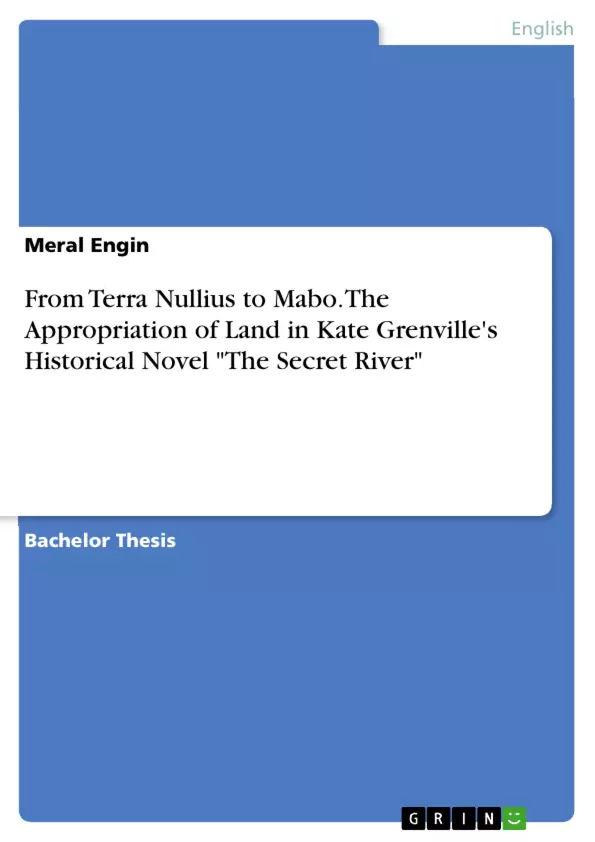This paper tries to reconstruct the history of European Settlers coming to Australia in order to build up a new existence on foreign ground. The overall aim is to establish an understanding of the concept of terra nullius that labeled Australia literally into a no man’s land and thereby justified and enabled its annexation by the inrushing convicts, settlers, entrepreneurs and adventurers.
Within colonial discourse a colony was founded on the acquisition of land by occupation or settlement of a terra nullius. Although the presence of the Indigenous peoples was acknowledged, they were considered to be primitive and uncivilised. According to the colonial power without any visible political system the Indigenous peoples had no sovereignty over the land and no laws that would assert their land rights. Driven by the empowerment of terra nullius the newcomers claimed land as their own, mapped and named it.
With these insights the focus of this paper will shift to the historical novel The Secret River by Kate Grenville in order to follow the protagonist William Thornhill’s efforts to build up a new existence for his family in Australia and to present how the settlers’ motivations and methods of claiming and possessing of land were implemented. The dispossession of the Indigenous peoples of Australia was legally recognised through the Mabo judgement in 1992 that overturned the terra nullius fiction and acknowledged that Indigenous peoples had lived in Australia for thousands of years and enjoyed rights to their land according to their own laws and customs.
Inhaltsverzeichnis (Table of Contents)
- Introduction
- The Key Concepts: Terra Nullius and Cartography
- Settler Colony Australia
- The History of the Settlers and the Beginnings of Settlements
- Frontier Conflicts: European Settlers and their Expectations towards the Land and the Indigenous Peoples
- Establishing White Hegemony at all Costs
- Australia's Unsettled History: The Secret River by Kate Grenville and its Implications for the "History Wars"
- The History of Australia in The Secret River
- The Concept of Terra Nullius through the Imperial Gaze and its Implementation by the Settlers
- Land Acquisition: The Principle Of "First Come, First Serve" and William Thornhill's Dream and Annexation of Land
- The Indigenous View of Land and Land Ownership according to the Settlers
- The Mabo Case and its Implications: Terra Nullius, a Fiction of Colonial Discourse
Zielsetzung und Themenschwerpunkte (Objectives and Key Themes)
This paper aims to explain the concept of terra nullius, which labelled Australia a no man's land, and exemplify its representation in Kate Grenville's The Secret River. The paper analyzes the impact of terra nullius on the dispossession of Indigenous Australians, highlighting the historical context of settler colonialism and the "history wars" that continue to shape Australian history.
- The concept of terra nullius and its implementation in colonial Australia
- The impact of terra nullius on Indigenous Australians
- The historical context of settler colonialism in Australia
- The "history wars" and the ongoing debate over the interpretation of Australian history
- The role of literature in engaging with and challenging the legacy of terra nullius
Zusammenfassung der Kapitel (Chapter Summaries)
- Introduction: The introduction sets the stage for the paper by introducing the concept of terra nullius and its significance in Australian history. It also outlines the paper's objective, which is to examine the representation of terra nullius in Kate Grenville's novel The Secret River.
- The Key Concepts: Terra Nullius and Cartography: This chapter defines the key concepts of terra nullius and cartography, which are crucial to understanding the colonization of Australia.
- Settler Colony Australia: This chapter provides a historical overview of the settlement of Australia by European colonists. It explores the motivations of the settlers, their relationships with Indigenous Australians, and the establishment of white hegemony.
- Australia's Unsettled History: The Secret River by Kate Grenville and its Implications for the "History Wars": This chapter examines the representation of terra nullius in The Secret River. It explores how the novel illustrates the implementation of this legal framework by the European settlers, focusing on the protagonist William Thornhill's ambitions and motivations.
- The Mabo Case and its Implications: Terra Nullius, a Fiction of Colonial Discourse: This chapter discusses the significance of the Mabo case in overturning the concept of terra nullius and recognizing the rights of Indigenous Australians.
Schlüsselwörter (Keywords)
The primary keywords and focus topics of this paper include: terra nullius, settler colonialism, Indigenous Australians, Australian history, "history wars", The Secret River, Kate Grenville, Mabo case, native title, and postcolonial literature. These terms highlight the core concepts and themes related to the dispossession of Indigenous Australians and the ongoing debate over the interpretation of Australian history.
- Quote paper
- Meral Engin (Author), 2017, From Terra Nullius to Mabo. The Appropriation of Land in Kate Grenville's Historical Novel "The Secret River", Munich, GRIN Verlag, https://www.grin.com/document/438933



